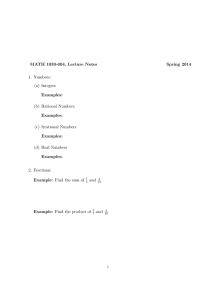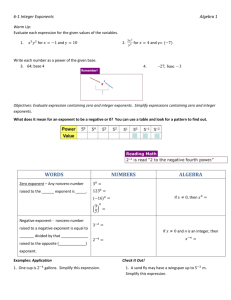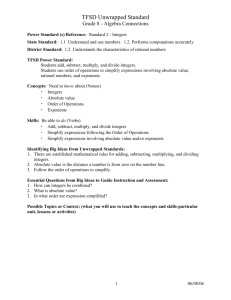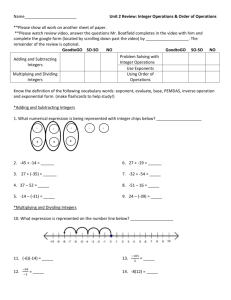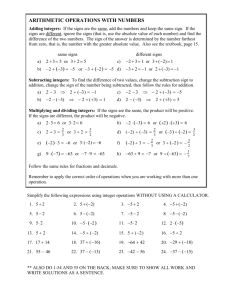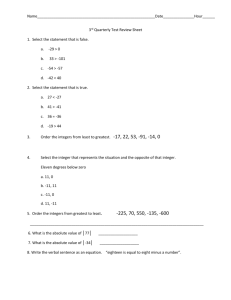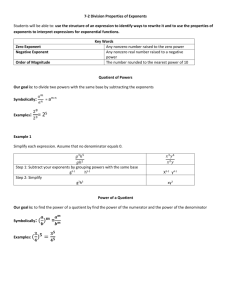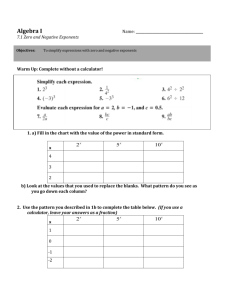11/12: Can I Simplify Expressions with Negative Exponents?
advertisement
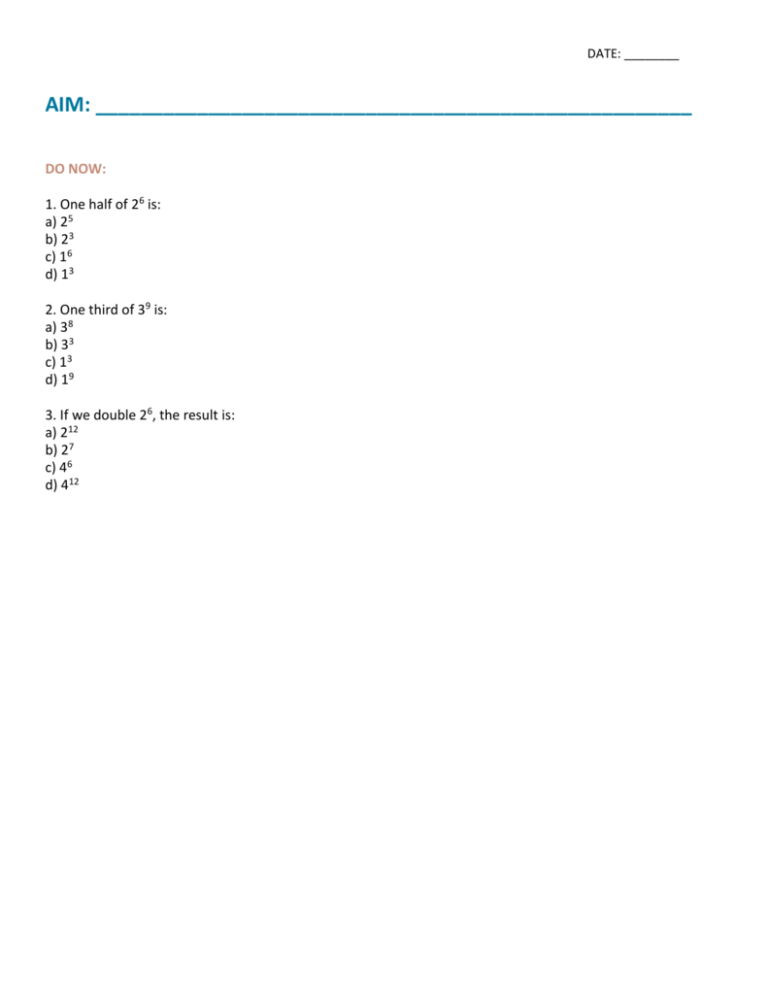
DATE: ________ AIM: _____________________________________________________ DO NOW: 1. One half of 26 is: a) 25 b) 23 c) 16 d) 13 2. One third of 39 is: a) 38 b) 33 c) 13 d) 19 3. If we double 26, the result is: a) 212 b) 27 c) 46 d) 412 NEGATIVE EXPONENT RULE Definition: For any positive number 𝑥 and for any positive integer 𝑛, we define 𝑥−𝑛 = Note that this definition of negative exponents says 𝑥−1 is just the reciprocal, 1 𝑥 1 𝑥𝑛 . , of 𝑥. As a consequence of the definition, for a positive 𝑥 and all integers 𝑏, we get 𝑥−𝑏 = 1 𝑥𝑏 . WHY? LET’S LOOK AT A MODEL. BASE 10 BASE 2 BASE _____ SUMMARY: If we have an integer base with a negative exponent, then it’s value is a _____________________ We never leave exponents negative! We must change them to a positive exponent by ________________________________ ________________________________________________________________________________________________________. EXAMPLES: For Exercises 1-6, write an equivalent expression, in exponential notation, to the one given and simplify as much as possible. Exercise 1 Exercise 2 5−3 = 1 = 89 Exercise 3 Exercise 4 3 ∙ 2−4 = Let 𝑥 be a nonzero number. 𝑥 −3 = Exercise 5 Exercise 6 Let 𝑥 be a nonzero number. Let 𝑥, 𝑦 be two nonzero numbers. 1 = 𝑥9 𝑥𝑦 −4 = We accept that for positive numbers 𝑥, 𝑦 and all integers 𝑎 and 𝑏, 𝑥 𝑎 ∙ 𝑥 𝑏 = 𝑥 𝑎+𝑏 𝑎 (𝑥 𝑏 ) = 𝑥 𝑎𝑏 (𝑥𝑦)𝑎 = 𝑥 𝑎 𝑦 𝑎 . We claim 𝑥𝑎 𝑥𝑏 𝑥 𝑎 = 𝑥 𝑎−𝑏 for all integers 𝑎, 𝑏. 𝑥𝑎 (𝑦) = 𝑦𝑎 for any integer 𝑎. Exercise 7 Exercise 8 192 = 195 𝟏𝟕𝟏𝟔 = 𝟏𝟕−𝟑 Exercise 9 SIMPLIFY then EVALUATE: 𝟑𝟑 × 𝟑𝟐 × 𝟑𝟏 × 𝟑𝟎 × 𝟑−𝟏 × 𝟑−𝟐 = SIMPLIFY then EVALUATE : 52 × 510 × 58 × 50 × 5−10 × 5−8 = SIMPLIFY (𝑎 ≠ 0) : 𝑎𝑚 × 𝑎𝑛 × 𝑎𝑙 × 𝑎−𝑛 × 𝑎−𝑚 × 𝑎−𝑙 × 𝑎0 = Equation Reference Sheet For any numbers 𝑥, 𝑦 (𝑥 ≠ 0 in (4) and 𝑦 ≠ 0 in (5)) and any positive integers 𝑚, 𝑛, the following holds: 𝒙𝒎 ∙ 𝒙𝒏 = (1) (𝒙𝒎 )𝒏 = (2) (𝒙𝒚)𝒏 = (3) 𝒙𝒎 = 𝒙𝒏 𝒙 𝒏 ( ) = 𝒚 (4) (5) For any positive number 𝒙 and all integers 𝒃, the following holds: 𝒙−𝒃 = (9)
